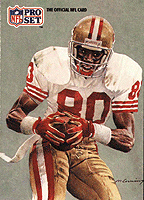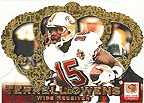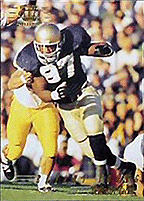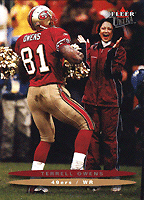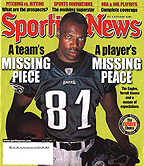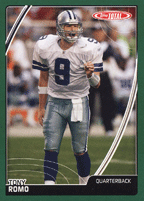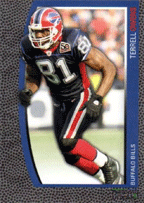| Terrell Owens — Biography | |||||
| bio | facts | what they say | my say | ||
For all his skills—and you would need a box of Sharpies to list them—Terrell Owens is better known for his antics outside the white lines than his accomplishments between them. Inappropriate touchdown celebrations, whining that he doesn’t see the ball enough, off-season reality TV shows, forcing the hand of management with threats and demands—none of this has earned him the admiration of fans. But if they knew of his tortured past and hard road to the NFL, Terrell might just win their hearts and shed the label of football’s most misunderstood star. This is his story…
| |
GROWING UP
Terrell Eldorado Owens was born December 7, 1973, in Alexander City, Alabama. (Click here for today's sports birthdays.) Terrell was the first son to his mother, Marilyn Heard. Only 17 at the time, she was the product of a dysfunctional family herself. Most of Marilyn's childhood was spent in fear and silence. Her mother, Alice, was reportedly cruel to her children (though this claim has been challenged.) Alice raised Marilyn in a confined environment with little love or support. Marilyn wasn't allowed to play with other children and had to come home directly after school. If she didn't, she would pay the price in welts and bruises.
A man named L.C. Russell lived across the street with his wife and kids. Russell was 14 years older than Marilyn, but that didn't matter to either. She craved love and human contact, and he became the father of Terrell. Despite the awkward situation, Russell stayed in the neighborhood with his family.
Marilyn tried to keep her pregnancy a secret from her mother and stepfather, but could only do so for only so long. One night Marilyn's younger sister ran away to live with an aunt. She remained at home with Terrell, who was just a baby.
After Terrell, Marilyn had a girl named Latasha. She was married to the infant's father for a brief time. Then in the early ’80s came two more babies—Sharmaine and Victor—fathered by another man.
Terrell often stayed with his grandmother Alice. She was as hard on him as she was on Marilyn. Alice gave him a bike. but he could only ride it in the yard. Terrell was permitted no spare time with his friends and couldn't watch TV. He was also whipped regularly. For all the abuse, however, Terrell loved Alice, viewing her as a second mother.
When Terrell was young, Alice's marriage fell apart and she began drinking heavily. The youngster often had to take care of her until she sobered up. One time Alice was so intoxicated, she put her purse in the oven and burned up all her money. Ironically, Alice seemed to lighten up as her alcohol problem worsened. She even bought Terrell a go-cart, which they would drive on the highway.
When Terrell turned 12, he befriended a girl across the street. Her father noticed and confronted him, warning Terrell that the girl was actually his half-sister. Thus the youngster learned who his father was.
To escape his tortured home life, Terrell became immersed in sports. Basketball, baseball and swimming were his favorites. He also loved football, idolizing San Francisco star Jerry Rice. Terrell played despite stark opposition from Alice. Marilyn, by contrast, supported her son completely, knowing sports made him happy.
Marilyn bounced from job to job and often found herself back in Alice’s house with Terrell. Her other children hated it there, however, so she eventually moved with them into a beat-up two-bedroom home. Terrell stayed with Alice because there simply wasn’t room for him in the cramped dwelling.
Terrell’s athletic career began to blossom when he entered Benjamin Russell High School in the fall of 1988. During his career, he lettered four times in football and track. He also earned three letters in basketball and one in baseball. Terrell actually didn't start for the football team until his senior year. He even thought about quitting the sport, but his coaches talked him out of it. They saw great talent in him, even if he didn’t yet.
Tall, lanky and exceedingly fast, Terrell had the skills to play Division I football. But recruiters were slow to scout him. In fact, many got their first look at him only because they were watching teammates who were also excellent prospects. Few schools pursued Terrell as aggressively as the University of Tennessee at Chattanooga. The coaches there had no problem with Terrell becoming a multi-sport star. For the teenager, the opportunity to compete in more than one sport at the college level was a major selling point.
ON THE RISE
With the Moccasins, Terrell flashed every last bit of his athletic ability. He lined up at forward on the basketball team for three years, including five starts for the UTC squad that qualified for the NCAA tournament in 1995. In his senior year, he anchored the school’s 4x100 relay team.
It was on the gridiron, however, where Terrell truly distinguished himself. An explosive receiver, he wore number 80 in honor of his hero, Rice. In his freshman year, he was used sparingly as a backup. In six games in 1992, Terrell caught six passes for 97 yards and a touchdown. When the Mocs finished 2-9, head coach Buddy Nix was shown the door.
Tommy West was hired to replace to Nix the following season, but didn’t have a whole lot to work with. One thing the new coach discovered was Terrell’s gamebreaking ability.The soph emerged as a starter, seeing time in all of UTC’s 11 games. For the season, he hauled in 38 passes for 724 yards and eight touchdowns. His biggest day came against Marshall, when he set a school record with four TDs. The Moccasins improved to 4-7, but just 2-6 in the Southern Conference. That wasn’t enough to save West’s job.
Brought in to lead the team in 1994 was Buddy Green. His top priority was strengthening UTC’s porous defense. Green, however, could only do so much. The Mocs struggled again, posting a record of 3-8. Like West, Green learned to get the ball in Terrell’s hands as often as possible. The junior developed into UTC’s main offensive weapon, posting 58 receptions for 836 yards and six touchdowns. He also carried the ball four times for 35 yards. His performance earned him second-team All-Southern Conference honors.
Heading into the 1995 season, Green focused his offensive game plan around Terrell. For the first time in his college career, he would be returning kickoffs, and he remained the primary target in the passing attack. But enemy defenses were ready for Terrell. He was regularly blanketied with double-coverage.
The increased attention paid to Terrell resulted in a decline in his receiving numbers. In turn, the Mocs suffered without their star receiver controlling the action and finished at 4-7. While Terrell's stats—43 receptions for 666 yards and a touchdown—were more than respectable, they didn’t wow anyone in the pro ranks.
![]()
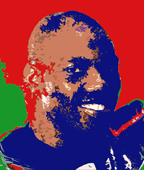
Terrell figured to be drafted, but he didn’t know how high he would go. At 6-3 and more than 200 pounds, he had the size to play in the NFL. Speed wasn’t an issue, either. Terrell had honed his running technique on the track and was also a handful to bring down after the reception. Working against him was the conference he played in and the quality of competition he faced.
Among the teams interested in Terrell were the 49ers. A year earlier, they had traded up to pick J.J Stokes out of UCLA. But when his development stalled, San Francisco was again in the market for a receiver to bracket Rice. For Terrell, the thought of taking the field with his hero—not to mention quarterback Steve Young—was almost too much to hope for. When the 49ers tabbed him in the third round as the 89th pick overall, he could barely contain his excitement.
San Francisco entered 1996 campaign looking to recapture past glory. George Seifert remained the head coach, and back in the fold in the front office was Bill Walsh. Putting points on the board wasn’t going to be a problem. Shutting down opponents didn’t appear to be one, either. Bryant Young was among the league’s best on the defensive line, and Tim McDonald and Merton Hanks were solid at the safety positions.
Terrell came into training camp as a shy rookie. He took advice from Rice and other veterans, but he didn't get involved with his teammates much beyond that. Working hard and biding his time, Terrell waited for the chance to prove himself on the field. Early on, he made his biggest impact on special teams. Against the Atlanta Falcons in September, he recorded a season-high three tackles.
His opportunity on offense presented itself when Stokes went down with an injury. In his first start, in October game against the Cincinnati Bengals, Terrell caught four passes for 94 yards, including 45-yard touchdown to tie game late in fourth quarter. From there, he grew more comfortable and developed into a valuable contributor. Over San Francisco’s final 10 games, he posted 32 receptions for 488 yards and four touchdowns. By the campaign’s end, he was second on the team to Rice in catches and receiving yards.
The Niners finished second in the NFC West at 12-4, despite a rocky year by Young, who suffered two concussions. Hoping for a run the playoffs, they were quickly dismissed by the Brett Favre and the Green Bay Packers.
Off San Francisco’s disappointing postseason performance, the team continued to transform itself. Seifert retired and was replaced by Steve Mariucci. With Young turning 36 and Rice soon to celebrate his 35th birthday, age was the enemy of the new head coach. To take pressure off the passing game, the Niners signed running back Garrison Hearst. On defense, the front seven remained formidable, while the secondary was no better than average.
When Rice and Young got nicked up on the season’s opening Sunday, it looked like San Francisco would be in for a long year. But Terrell was one of several players to step up in their absence. The team jumped out to a 4-1 record with the help of the league’s top defense—not to mention four touchdown catches from Terrell. By November, he had become the Niners’ #1 receiver. Following in the footsteps of Rice, Terrell was usually most dangerous after the catch. For the year, he almost doubled his rookie numbers with 60 receptions for 936 yards and eight touchdowns.
San Francisco surged to a 13-3 record, good for first in the NFC West. In the playoffs, they faced off against Minnesota and drubbed the Vikings, 38-22. Terrell, Rice and Stokes easily matched the production of Minnesota’s explosive trio of Randy Moss, Cris Carter and Josh Reed. A week later, the Niners again ran smack into the Packers for the second year in a row, losing 23-10 in the NFC Championship Game. It was their fifth defeat in the last four years to Green Bay. Terrell did all he could, catching six balls for 100 yards.
Hopes were sky high in San Francisco in preparation for the 1998 campaign. Rice returned, and Mariucci promised to open up the passing attack. Defensively, Dana Stubblefield left via free agency, but Young and Junior Bryant were still a terrific duo up front. In the defensive backfield, R.W. McQuarters, San Francisco’s first-round pick from Oklahoma State, looked to settle in at one of the corners.
The 49ers were unstoppable to begin the season. With blowout wins in their first two games, they ranked first in the NFL in rushing and passing. Terrell was leading the way, literally and figuratively. Off to the best start of his career, he escorted Hearst into the end zone on a 96-yard touchdown run for an OT victory over the New York Jets. Two months later, he burned the other Big Apple team, as the Niners rolled to a 31-7 shellacking of the Giants. Terrell hauled in a 79-yard touchdown pass, while Hearst rushed for 166 yards. The victory pushed San Francisco to 9-3, securing the team's 16th straight winning season.
The 49ers headed into December in a dogfight with Atlanta for the division title. Terrell did his part with a TD reception in each of his last eight games, but the Falcons held on for first place in the NFC West. That set up a playoff matchup with nemesis Green Bay. The situation grew desperate when the Packers seized a fourth-quarter lead, 27-23. Young guided the Niners downfield, and with three seconds left he crouched under center for a final snap from the Packers' 25-year-line. After tripping over a teammate’s foot, he spotted Terrell near the goal line and fired a strike. Terrell got hammered as the ball reached him and somehow managed to hold on to deliver a thrilling 30-27 win.
San Francisco next travelled to Atlanta. Unfortunately, in one play the Niners’ Super Bowl aspirations were crushed. Hearst was felled by a broken left fibula, and the team was stripped of its best runner. The Falcons eeked out a 20-18 victory.
Topping San Francisco’s 1999 to-do list was finding Hearst’s replacement. The team signed running backs Charlie Garner and Lawrence Phillips, and also added Charles Haley to bolster the defense. But age and injuries continued to wear down the 49ers. Young was out with a series of concussions, and Rice’s yards-per-catch dipped to a career low. When Mariucci was forced to turn to a pair of young quarterbacks, Jeff Garcia and Steve Stenstrom, the team fell apart. After a 3-1 start, the Niners dropped eight straight and ended with a dismal 4-12 record.
Terrell suffered through the year like the rest of the team. At 60 receptions for 754 yards and four touchdowns, his stats dropped in all areas. And with Young announcing his retirement, Terrell realized he would have to develop chemistry with a new starting quarterback, most likely Garcia.
MAKING HIS MARK
Headin into the 2000 campaign, the San Francisco brass tried to the plug the holes in the team’s secondary. This was done through the draft again, with Ahmed Plummer from Ohio State and Jason Webster from Texas A&M. They joined a defensive unit that had a lot to prove.
The same could be said of the offense. Garcia was handed the quarterback Job, Rice wasn’t getting any younger, Garner’s durability was called into question, and Terrell was coming off a sub-par year. Early in the year, the Niners visited Dallas. San Francisco jumped out to a big lead and built it further on a touchdown pass to Terrell. Unable to control his emotions, he sprinted to the star in the middle of the field in a celebration that clearly offended the Cowboys. When Terrell scored again and repeated his actions, some on the opposing sideline had seen enough, including George Teague, who blindsided the San Francisco receiver.
The 49ers were also incensed. The team suspended Terrell for a week and fined him $24,000. He reacted angrily to what he perceived as a lack of support from the organization. The media was having a field day with his performance in Dallas, and in his mind the club left him alone in his time of need.
From there, the season
degenerated for San Francisco. The Niners finished under .500 for the
second year in a row. The team was awful on defense, surrendering a whopping 422 points.
The saving grace was Rice, who was showing few signs of slowing down in his final campaign in a Niner jersey. The legendary receiver was showered with one loud ovation after another in a December contest against the Bears, his last in his home stadium. It was Terrell, however, who stole the show. Running free all day long in the Chicago secondary, he logged an NFL-record 20 receptions for 283 yards. Terrell’s reputation aside, many viewed the contest symbolically—the greatest pass-catcher of all time handing the torch to the guy eager to assume that mantle.
When the year ended, despite missing two games, Terrell enjoyed his best season as a pro. His 97 receptions and 1,451 yards were career highs, and he also scored 13 touchdowns. Terrell earned a trip to Hawaii for his first Pro Bowl. Garcia, who blossomed in the starter’s role, also got the nod.
The offseason, however, was hard on Terrell. Vilified in the press, he kept to himself, not eager to face the scrutiny of reporters and fans. Still feeling betrayed by Mariucci and the 49ers, he entered the 2001 season with a chip on his shoulder. Teammates avoided him in the locker room, which isolated Terrell further.
Prognosticators noted the simmering discontent and predicted another down year for San Francisco. But the 49ers won four of their first five, with a big boost from Terrell. He posted back-to-back games of more than 100 receiving yards in October, including a huge day against Atlanta when he tied the contest with a TD in the fourth quarter and produced a victory with a 52-yard touchdown in OT.
A week later, Terrell landed himself in hot water again. San Francisco blew a 19-point lead in Chicago, losing in overtime after Terrell mishandled a pass that Bears free safety Mike Brown intercepted and returned for the game-winning score. Afterwards, Terrell accused Mariucci of protecting good friend and Chicago head coach Dick Jauron, whose job was on the line. Mariucci bristled at the comment. He openly questioned Terrell in the papers.
Ironically, the feuding seemed to energize the Niners. They finished at 12-4 to break their postseason drout. The play of Garcia and Hearst—who defied the odds and returned to top form—had a lot to do with San Francisco’s turnaround. But no one made more of a difference than Terrell. Despite a gimpy foot and ankle, he was the team’s go-to guy. On the year, he recorded 93 receptions for 1,412 yards and 16 touchdowns. He was selected to the Pro Bowl for the second time and earned first team All-Pro honors from the Associated Press.
Unfortunately, the playoffs brought more disappointment, as the Niners lost to Packers, 25-15. Terrell caught just four passes, and a ball thrown in his direction that would have given San Francisco a lead was tipped away. In the locker room, he talked to the press about how his frustration. Center Jeremy Newberry overheard the conversation and advised Terrell to keep quiet. That was it. Terrell called his agent and demanded a trade out of San Francisco.
In the offseason, Mariucci interviewed for the Tampa Bay coaching job. When he didn’t get it, he flew to Terrell's home to patch things up. The coach was smart enough to realize two things. The Niners were a much better team with Terrell, so he wasn’t going anywhere. Also, since the receiver was staying, their relationship had to become at least civil.
The talk heading into the 2002 campaign was that San Francisco could contend for a title as long as Terrell remained focused. The defense had improved greatly in ’01, and with rookies Mike Rumph and Saleem Rasheed in camp. the unit was even deeper. On offense, Hearst was fully healthy, and Garcia was emerging as one of the NFL’s best signal callers.
The 49ers started the campaign at 2-2. Playing in Seattle in a key division showdown, Terrell hauled in the game-winning touchdown in the 28-21 victory. What he did after his score, however, caused a national uproar. Terrell pulled a Sharpie out of his sock, signed the ball, and handed it to his financial adviser sitting in an end zone luxury suite rented by Shawn Springs, the cornerback he had just beaten. To no one’s surprise, Terrell was crucified for his display. Seahawks coach Mike Holmgren said he dishonored the game. ESPN analysts Sean Salisbury, Dennis Green and Tom Jackson ripped him, too. Stung by the criticism, Terrell allowed a camera into his home so he could defend himself on live TV.
After the Sharpie
incident, Terrell dug himself a bigger hole. Bringing race into conversation,
he said the NFL targeted black players with rules restricting touchdown
celebrations. His arguments fell mostly on deaf ears.
As he had done in the past, Terrell separated himself from his off-field problems and put together a monster season. He established a career-high with 100 receptions, which were good for 1,300 yards and 13 TDs. The Niners, meanwhile, went 10-6, finishing first in the weak NFC West.
San Francisco's first playoff game was a thriller against the Giants. Down by 14 points at halftime, Terrell challenged his teammates to fight their way back. But when the 49ers found themselves behind 38-14, the game looked like it was over. Terrell spearheaded a furious comeback. Showing leadership he had never displayed before displayed, he reeled in nine passes for 177 yards and two touchdowns, plus a pair of two-point conversions. San Francisco won 39-38 in miraculous fashion, and Terrell was among the heroes.
Unfortunately, the 49ers got throttled a week later in Tampa Bay, as the surging Bucs crushed them 31-6. Terrell had four catches for 35 yards in the game, which was over by halftime.
The aftershocks of that loss were felt in the weeks that followed. Mariucci was fired, in part because he let the clock run out with 50 seconds remaining in the second quarter in Tampa. The implication to many watching the game was that he was throwing in the towel. In Mariucci's place, the Niners hired Dennis Erickson. The new coach kept offensive coordinator Greg Knapp around, but on the condition that he go down field with the ball more often. That was good news to Terrell.
In the preseason, a quarterback controversy developed between Garcia and Tim Rattay. The sticky situation divided the team. Terrell added to the problem after a regular-season loss to Minnesota when he screamed at Knapp about the game plan. When Erickson failed to exert enough control over the squad, the campaign spiraled downward even farther. The Niners went 7-9 and missed the playoffs. Terrell had a poor year by his standards. Though he made his fourth straight Pro Bowl, his numbers fell off (80 receptions,1,102 yards and nine touchdowns). Again he was unhappy.
Terrell and the team mutually agreed to part ways after the season. Predictably, even that didn’t go smoothly. Set to become a free agent, Terrell forfeited his status when his agent failed to file the proper paperwork. Still a 49er, he was traded to Baltimore, a move that infuriated him because he wanted to play for the Eagles. Eventually, a settlement was reached with Terrell going to Philadelphia in a three-way deal including the Ravens.
Terrell was elated to become an Eagle. Eager to team up with Donovan McNabb, he also knew that running back Bryant Westbrook had the potential to be a star. The defense, meanwhile, was bolstered with the addition of Jevon Kearse, a move which had many talking Super Bowl in Philly.
Terrell, however, wasn't going to change to ingratiate himself to his new teammates or fans. He complained during the preseason about not seeing the ball enough, and in an interview with Playboy, he hinted that his former quarterback Garcia was gay. Terrell later recanted that statement.
Terrell might have wanted the ball on every play, but he nearly missed the first few downs of his Philly career. Prior to opening day against the Giants, Terrell left his home with what he thought was ample time to make it to Lincoln Financial Field. A few hours later he found himself stuck in a massive traffic jam, surrounded by fans also on their way to the game. Terrell exited the highway, flagged down a police officer, and arranged his own personal escort to the stadium. His harried arrival had little effect on his Eagles debut. In a 31-17 blowout, he caught eight passes for 68 yards and three scores. Terrell's impact on the Philadelphia offense was obvious—his three TDs were more than any Philadelphia wide receiver had in the entire '03 season.
The Eagles beat the
Vikings a week later on Monday Night Footbal, 27-16. Terrell had another
big game, with four catches for 79 yards and a touchdown. With the win,
Philly started 2-0 for the first time in 11 years. Afterwards, reporters
fished for a quote form Terrell knocking McNabb and head coach Andy Reid
for the lack of balls thrown his way. He didn't take the bait.
Philly took its next five games, giving the team an early stronghold on the NFC East and the best record in the conference. In each contest during the stretch, Terrell topped 100 yards receiving. He also stepped up his touchdown celebrations. Against the Bears, Terrell did six sit-ups after hitting paydirt, one for each of his TD catches to that point in the season. In Cleveland, Browns fans let him have it for his comments about their new quarterback Garcia. Terrell caught two touchdown passes in the first half, and then tore down signs berating him. A week later, in a 15-10 over Baltimore, he mocked Ray Lewis's "Squirrel" dance, gyrating in the end zone after a TD that put the contest on ice.
Philly's seven-game winning streak ended in Pittsburgh, as the Steelers rolled to a 27-3 victory. The Eagles rebounded with a 49-21 laugher over Dallas. Terrell had a huge game, with six recpetions for 134 yards and three scores. But no one was talking about his play on the field the next day. Again, Terrell touched off a firestorm of controversy before the Monday Night affair when he appeared in a racy promotion with Nicollette Sheridan of the ABC show, Desperate Housewives. The spot—which had the two in the locker room before the contest—featured suggestive dialogue and ended with the curvy actress dropping the towel she was wrapped in.
Some saw the promo as repulsive. Some thought it was funny. Others didn’t care. Ultimately, amid league pressure, Terrell apologized, as did ABC and Sheridan.
Terrell's best effort of the campaign came a short time later against the Packers. In a 47-17 whitewash, he caught eight passes for 161 yards, including his 14th touchdown of the season. It was his seventh 100-yard receiving game of '04, breaking the franchise mark held jointly by Mike Quick and Irving Fryar.
Two weeks later, disaster
struck for Terrell and the Eagles at home against the Cowboys. On the
second play of the third quarter, he hauled in a short pass and tried
to elude Roy Williams. But when the Dallas safety ripped down Terrell
awkwardly, his right foot stuck in the turf and he fractured his leg.
In an instant, it appeared that Philly's Super Bowl juggernaut had been
derailed. Though the team had homefield advantage locked up throughout
the playoffs, many in the media felt the Eagleswould be unable to mount a consistent
offensive attack without their game-breaking receiver.
McNabb rose to the occasion in Philadelphia's postseason opener, a 27-14
win over Minnesota. Playing a near-perfect game, he completed 21 passes
for 286 yards and two touchdowns. Receiver Freddie Mitchell picked up
the slack in Terrell’s absence, catching five passes for 68 yards
and a touchdown. Westbrook also caught a touchdown pass and rushed for
70 yards.
Terrell hoped to make it back for the NFC Championship Game against the Falcons, but his leg was not ready. The Eagles instead relied on their defense against Atlanta, confusing quarterback Michael Vick with a vareity of blitzes and zone coverages. McNabb, meanwhile, authored another solid performance, tossing a couple of TDs and posting a 111.1 passer rating. Finally, after more than 20 years of frustration, Philly fans celebrated their club's return to the Super Bowl.
For the next two weeks, newspapers, magazines and TV sports shows devoted much of their energy to debate over whether Terrell would play in the the title game against the Patriots. He insisted he would suit up, even claiming that God was on his side. The team doctors disagreed, advising him to sit this one out. Terrell listened to the man upstairs. He was in uniform and ready to go by kickoff on Sunday night in Jacksonville.
While many football experts predicted Reid would use Terrell as a decoy, the coach worked him into the game plan almost immediately. Despite a limp that became more pronounced when he turned on the jets, Terrell was the best player on the field for the Eagles. He ran screens, slants, fades and go-routes. New England's banged-up secondary often lined up 10 yards off him, offering up an easy completion for McNabb whenever he wanted it.
The underdog Eagles hung tough with the Pats, sending the contest into the fourth quarter tied at 14-14. But turnovers and poor clock management ultimately sealed Philly's fate. New England took a 10-point lead in the final stanza, and then held on for a 24-21 victory. Terrell finished with nine catches for 122 yards, a heroic effort by any account.
The 2005 offseason was a raucous one for Terrell and the Eagles. His oil-and-water relationship with McNabb worsened when he commented publicly that he was not the one who got tired during the Super Bowl. Terrell maintained that his remark was taken out of context.
Later, through agent Drew Rosenhaus, he demanded his contract be renegotiated. The press jumped on Terrell for his greed, pointing out that he already had a $49 million deal. But it was heavily backloaded and incentivized, and the $3.5 million he was due to make was far below what many less-productive ends were earning.
Terrell talked about boycotting camp, but decided to show. As negotiations dragged on, he became critical of Philadelphia owner Jeff Lurie, and then antagonized Philly fans on his radio program. After a November locker room tussle with ex-Eagle Hugh Douglas and another public jab at McNabb, the team suspended Terrell for four games. Later, he was deactivated him for the remainder of the season.
In his abbreviated campaign, Terrell still managed to attain some impressive personal milestones. He caught his 100th TD pass and logged his 10,000th receiving yard. The Eagles were 4–3 when they ended Terrell’s season. They won just two more games that year.
The Eagles knew what they were getting when they signed Terrell, on and off the field. After the Super Bowl, for instance, he criticized the media for shortchanging him. When Brett Favre played in pain, he argued, the Green Bay quarterback was hailed as the paragon of gridiron courage. In his case, he observed, some media members actually accused him before the game of being selfish and egotistical for wanting to return to the field.
But even if Terrell had a point, Philadelphia wasn’t interested in listening. The team released Terrell in the spring of 2006. Jerry Jones scooped him up for the Cowboys a few days later. Dallas inked him to a three-year, $25 million deal. Terrell hurt his finger in the second game of the year, and doctors said he would be out at least a month. He vowed to return in time for the Eagles game and beat that deadline by a week. Against the Tennessee Titans, he reeled in three TD passes from veteran Drew Bledsoe.
The Eagles game was a disappointment, howevever, as Dallas lost 38–24. Terrell’s “homecoming” was accompanied by the expected chorus of boos. He caught just three passes. After the game, Terrell launched an angry tirade at his teammates. He asked why the Cowboys had bothered to sign him. Part of his anger was attributable to the fact he had re-injured his finger during the game. This time doctors wanted to shut him down for the year. Terrell said forget it and kept playing.
| |
he following week, coach Bill Parcells made backup Tony Romo his starter. The Cowboys were reenergized. They won five of their next six and knocked off the undefeated Indianpolis Colts. Romo found an inviting target in Terrell, who ended up leading the NFL with 13 TD catches (on 85 receptions for 1,180 yard)s. Working the other side of the field for the Cowboys was a resurgent Terry Glenn. He gained over 1,000 yards as well.
Dallas headed for the playoffs for the first time since 2003 and had a shot at the NFC East crown until a last-week loss to the lowly Lions pushed them back to Wild Card status. Dallas faced the Seahawks in the opening round. It was a tense game that the Cowboys had a chance to win with a chip-shot 19-yard field goal. Unfortunately, Romo muffed the snap and was tackled as he tried to run the ball into the end zone.
Terrell opened the 2007 season with a two-touchdown performance against the Giants. Dallas scored 45 points in the game and continued to rack up big offensive outputs as the season progressed. In fact, the Cowboys scored 24 points or more in their first 13 games, which earned them a record of 12–1. Their lone defeat came at the hands of the Patriots in what most fans took to be a preview of the Super Bowl. In October, Terrell caught a scoring pass in six straight games as Dallas kept rolling. He tallied four touchdowns against the Redskins in a 28–23 victory, basically winning the game singlehandedly.
The Cowboys didn’t lose their second game until December and finished 13–3 after resting their key players for much of the final game, a meaningless loss to Washington. Terrell ended his second year with the Cowboys with 81 catches for 1,355 yards and 15 touchdowns. His 90 points ranked fifth in the NFL among non-kickers.
With homefield advantage throughout the playoffs, the Cowboys saw their road to the Super Bowl sufficiently greased. After a bye week, they faced the Giants, who they had already beaten twice. But the old axiom in the NFL, that it's hard to beat the same team three times in one year, proved to be the case. The teams started the second half knotted at 14–14. Dallas took the lead on a field goal, but New York hit paydirt with under two minutes left for a 21–17 win.
The Cowboys and their fans were shocked. But Dallas had overused fourth-quarter battering ram Marion Barber, and at crunch time Romo did not complete the throws he’d made all year. Terrell caught some heat, too. He had just four receptions for 49 yards and one touchdown in the game. Still, after the season, a record 13 Cowboys were selected to play in the Pro Bowl. Terrell was among them, earning this honor for the sixth time.
The Cowboys surged into the 2008 season focused on one thing—winning the Super Bowl. With Terrell primed to have another All-Pro season, and added depth at key positions, Dallas was considered a favorite in the NFC East.
Terrell’s first TD of 2008 came against the Browns on opening day. After the score, he did his best Usain Bolt impression, pretending to crouch down in the sprinter's blocks. The Cowboys were assessed a 15-yard penalty for excessive celebrating. For his next touchdow,n Terrell "broke the tape" as he crossed the goal line. This gesture did not draw a flag.
The Cowboys stumbled through the year with a 9–7 record and missed the playoffs. Terrell’s final numbers were 69 catches for 1,052 yards and 10 touchdowns—giving him 139 for his career. He averaged 15.2 yards per catch, which was roughly his career average. But behind the numbers there was friction between him and Romo, and also with tight end Jason Witten. Terrell was not a fan of Jason Garrett’s play-calling, either. Ultimately this proved to be his ticket out of Dallas.
Terrell claims he expected to be a Cowboy again in 2009, but the team had other ideas. Dallas released him in early March. Four days later the Buffalo Bills snapped him up, inking Terrell a one-year deal for more than $6 million. A few months later, his VH1 reality effort, "The T.O. Show," premiered. Fans got to follow Terrell and his cadre of pals and publicists in a unique image-burnishing adventure.
Terrell joined the Bills for training camp, and then missed a couple of weeks with a sprained toe. Watching from the sidelines robbed him of valuable time to create some rhythm with quarterback Trent Edwards. Coach Dick Jauron and Offensive Coordinator Turk Schonert hoped that Terrell could stay healthy and productive enough to take the heat off of fellow wideout Lee Evans when the Bills got into the red zone. Evans’s number in 2008 had been almost identical to Terrell’s with one glaring exception—he scored only three TDs. The Buffalo brain trust wanted that number to change.
Terrell caught two passes in the opener, a 25–24 Monday Night Football loss to the Patriots. A week later, he snagged his first scoring pass as the Bills evened their record against the Buccaneers. Terrell got behind the Tampa Bay defense for the 43-yard touchdown. His most dynamic scoring play in 2009 was a 98-yard TD pass in Week 11 in a loss to the Jaguars. It was the longest touchdown in team history and the longest of Terrell’s career.
By that point, however, the season had already gone south for Buffalo. Jauron had been fired, Edwards was benched, and the TO-Evans combo was yielding less than a touchdown a game. Terrell would finish with five scores and Evans with seven.
Terrell finished the year with 55 catches and 829 yards to lead Buffalo in both categories—not too shabby considering the Bills started three different quarterbacks. In the next-to-last game of the season, Terrell reeled in his 1000th career reception, joining five other NFL players in this elite group.
After the 2009 season, Terrell cast his fate upon the free agent waters. Concerns about his age and personality scared some clubs off, but few believed that he would go unsigned. They were right. Terrell inked a deal with the Cincinnati Bengals over the summer. Every team knows what he brings and what he costs. But what does Terrell really want? A little understanding ... and the football thrown his way whenever he’s open.
TERRELL THE PLAYER
Terrell’s 6-3, 226-pound body was made for football. He has a great work ethic, and it shows in his muscular physique. Terrell trains constantly—even doing push-ups in between shots while playing pool. He has the same type of attitude on the field. He prides himself on never loafing or taking off a snap.
Terrell is very athletic, which poses problems for opposing defensive backs. Playing basketball and running track in college helped him develop a multitude of skills. He is strong enough to muscle smaller corners and fast enough to blow by bigger ones. A great leaper, he also has terrific hands. Once he catches the ball, he is a load to bring down.
Few receivers do it all. Entering his late thirties, Terrell still does—and then some. But questions about his attitude will likely dog him for a long time. Even if he finally proves that team always come first with him, many will wonder when the next locker-room explosion or bizarre celebration will happen.
| Terrell Owens — Biography | |||||
| bio | facts | what they say | my say | ||
© Copyright 2010 Black Book Partners, LLC. All rights reserved.
